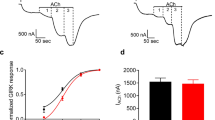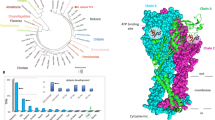Abstract
The enhanced metabolism of phosphoinositides, which is associated with a wide variety of stimuli and physiological responses, has been studied intensively. Berridge and his collaborators1–3 demonstrated that the first measurable reaction following cell membrane receptor activation is a rapid hydrolysis of phosphatidylinositol 4,5-bisphosphate (PtdIns(4,5)P2), and that the product of this reaction, inositol 1,4,5-trisphosphate (Ins(1,4,5)P3), could cause a release of non-mitochondrial calcium. These findings have been verified in other systems4–6. Although the relationship between the hydrolysis of PtdIns(4,5)P2 and the mobilization of intracellular calcium was clearly demonstrated, the direct link between Ins(1,4,5)P3 production and the physiological response was only implied. We have investigated the possibility that the intracellular release of Ins(1,4,5)P3 mediates the muscarinic–cholinergic response is Xenopus oocytes, and we show here that intracellularly injected Ins(1,4,5)P3 mimics the muscarinic depolarizing chloride current in Xenopus oocytes. This is the first demonstration of a direct link between phosphoinositides metabolism and a neuro-transmitter-induced physiological response.
This is a preview of subscription content, access via your institution
Access options
Subscribe to this journal
Receive 51 print issues and online access
$199.00 per year
only $3.90 per issue
Buy this article
- Purchase on Springer Link
- Instant access to full article PDF
Prices may be subject to local taxes which are calculated during checkout
Similar content being viewed by others
References
Berridge, M. J. Biochem. J. 212, 849–858 (1983).
Berridge, M. J., Dawson, R. M. C., Downes, P. C., Heslop, J. P. & Irvine, R. F. Biochem. J. 212, 473–482 (1983).
Streb, H., Irvine, R. F., Berridge, M. J. & Schulz, I. Nature 306, 67–69 (1983).
Agranoff, B. W., Murthy, P. & Seguin, E. B. J. biol. Chem. 258, 2076–2078 (1983).
Putney, J. W. Jr, Burgess, G. M., Halenda, S. P., McKinney, J. S. & Rubin, R. P. Biochem. J. 212, 483–488 (1983).
Poggioli, J., Weiss, S. J., McKinney, J. S. & Putney, J. W. Jr. Molec. Pharmac. 23, 71–77 (1983).
Kusano, K., Miledi, R. & Stinnakre, J. Nature 270, 739–741 (1977).
Dascal, N. & Landau, E. M. Life Sci. 27, 1423–1428 (1980).
Dascal, N., Landau, E. M. & Lass, Y. J. Physiol., Lond. 352, 551–574 (1984).
Dascal, N. & Landau, E. M. Proc. natn. Acad. Sci. U.S.A. 79, 3052–3056 (1982).
Robbins, N. & Molenaar, P. C. Proc. R. Soc. B213, 59–72 (1981).
Soreq, H., Parvari, R. & Silman, I. Proc. natn. Acad. Sci. U.S.A. 79, 830–834 (1982).
Dascal, N., Yekuel, R. & Oron, Y. J. exp. Zool. 230, 131–135 (1984).
Downes, P. C. & Michell, R. H. Biochem. J. 198, 133–140 (1981).
Downes, P. C., Mussat, M. C. & Michell, R. H. Biochem. J. 203, 169–177 (1982).
Bartlett, G. R. J. biol. Chem. 234, 466–468 (1969).
Fein, A., Payne, R., Corson, D. W., Berridge, M. J. & Irvine, R. F. Nature 311, 157–160 (1984).
Brown, J. E. et al. Nature 311, 161–163 (1984).
Author information
Authors and Affiliations
Rights and permissions
About this article
Cite this article
Oron, Y., Dascal, N., Nadler, E. et al. Inositol 1,4,5-trisphosphate mimics muscarinic response in Xenopus oocytes. Nature 313, 141–143 (1985). https://doi.org/10.1038/313141a0
Received:
Accepted:
Issue Date:
DOI: https://doi.org/10.1038/313141a0
This article is cited by
-
Differential role of STIM1 and STIM2 during transient inward (Tin) current generation and the maturation process in the Xenopus oocyte
BMC Physiology (2014)
-
The acetylcholinesterase inhibitor BW284c51 is a potent blocker of Torpedo nicotinic AchRs incorporated into the Xenopus oocyte membrane
British Journal of Pharmacology (2005)
-
Latency in the inositol lipid transduction pathway: the role of cellular events in responses to thyrotropin-releasing hormone in Xenopus oocytes
Pfl�gers Archiv European Journal of Physiology (1993)
-
Differential effects of cytoskeletal agents on hemispheric functional expression of cell membrane receptors inxenopus oocytes
Cellular and Molecular Neurobiology (1993)
-
Angiotensin II and acetylcholine differentially activate mobilization of inositol phosphates in Xenopus laevis ovarian follicles
Pfl�gers Archiv European Journal of Physiology (1992)
Comments
By submitting a comment you agree to abide by our Terms and Community Guidelines. If you find something abusive or that does not comply with our terms or guidelines please flag it as inappropriate.



